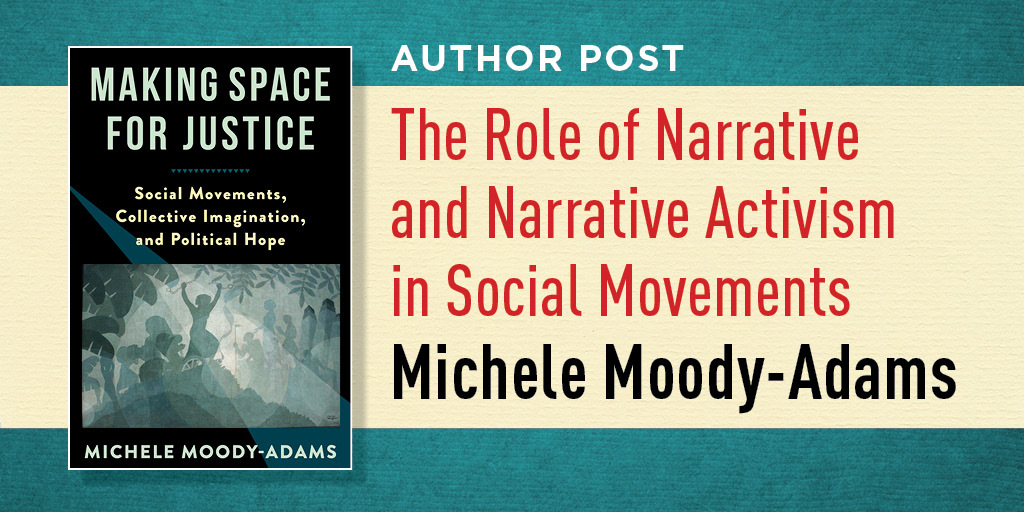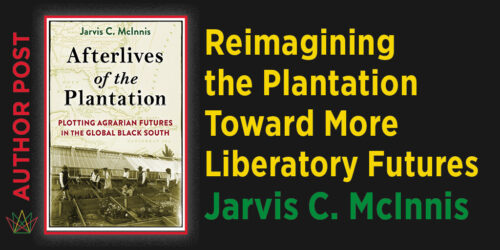The Role of Narrative and Narrative Activism in Social Movements
Michele Moody-Adams

It has often been said that “those who tell the stories rule the world.” Versions of this claim can be found in sources as varied as Plato’s dialogues, traditional Hopi wisdom, and a recent work such as Narrative Economics (2019) by Nobel laureate Robert J. Shiller. Efforts to draw on the power of narrative have even become central elements of many corporate advertising strategies.
The idea that narrative has the power to shape the world, and govern conduct, rests on a critical insight: narrative is the most important tool that we have for giving meaning to diverse actions, events, and states of affairs. One of my principal concerns in Making Space for Justice is to show what this insight means for social movements and, in particular, how it has informed a crucial set of methods and strategies that I call “narrative activism.”
Making Space for Justice focuses on narrative activism in regard to socially significant narratives, including the “grand narratives” through which some societies seek to provide a unified story about their origins and about how those origins shape—and ought to shape—the current character of their people and their institutions. Socially significant narratives have four characteristics that can profoundly affect the justice or injustice of institutions and practices framed by them. First, such narratives help to shape and sustain broadly shared understandings of a society’s collective history. Second, they help to sustain collective identities, primarily through the messages they convey about who “belongs” and why. Third, they provide cultural instruction about desirable belief and action by defining social roles through such concepts as gender, race, ethnicity, class, and age. Fourth, they often become mechanisms for legitimizing—and even “naturalizing”—those institutions and practices in which socially desirable beliefs and actions just happen to fit.
Once we understand how socially significant narratives work, we can see why it is sometimes impossible to remedy injustice unless we can first get a society to repudiate narratives that serve to legitimize and naturalize injustice. Making Space for Justice argues, for instance, that the Lost Cause narrative of the Confederacy—which denies the evils of slavery and defends oppressive and violent white supremacy—is an especially disempowering narrative and that Confederate monuments and iconography cannot be plausibly detached from it. In regard to an even more disturbing example, Making Space for Justice urges that a just society must disavow the dehumanizing “great replacement narrative,” which claims that white European-descended groups are being systematically “replaced” by (allegedly undeserving) nonwhite immigrants. This narrative has been used to justify hate-filled violence around the globe, and unless people of good will actively reject its claims it will continue to be an obstacle to genuine social justice.
Once we understand how socially significant narratives work, we can see why it is sometimes impossible to remedy injustice unless we can first get a society to repudiate narratives that serve to legitimize and naturalize injustice.
Much of the time, however, simply disavowing a dehumanizing and disempowering narrative may not be sufficient to make space for justice. Often, we must also make an active effort to construct and disseminate alternative narratives. What we need to produce is narratives that more accurately reveal the faces and facts of injustice and that serve, as the writer Chimamanda Ngozi Adichie urges, to “repair the broken dignity” of those who have been stigmatized and dispossessed.
Making Space for Justice argues that African American freedom struggles have generated some of the most important examples of narrative activism in human history. For instance, from the middle of the eighteenth century continuing into the beginning of the twentieth, slave narratives constituted powerful acts of narrative resistance that helped to assert the case for emancipation. At the start of the twentieth century, the historian Carter G. Woodson recognized the importance of narrative activism to correct the grand narrative of American history. Woodson rightly insisted on the need to accurately depict the critical role of African Americans in American life and to carefully record and teach the truth about African Americans’ rich contributions to American culture. At the end of the twentieth century, historian Annette Gordon-Reed’s research on the relationship between Sally Hemings and Thomas Jefferson offered a compelling continuation of the narrative activism begun by Woodson. DNA studies eventually confirmed the truth of her conclusion that Jefferson fathered Hemings’s children, reminding us that narrative activism can be an invaluable catalyst for the pursuit of historical truth.
Indeed, Making Space for Justice encourages us to be wary of narrative activism involving attempts to turn away from historical truth. In several egregious examples, school districts across the United States are being attacked for asking young people to come to terms with the truth of American chattel slavery and Jim Crow segregation, the injustices done to Indigenous peoples, and the horrors of the Holocaust. But one of the most important insights to emerge from the struggles conducted by social movements is that we have a duty not to look away from injustice. Indeed, as James Baldwin once urged, we have a duty to face “as much of the truth as we can bear.”
Making Space for Justice argues that African American freedom struggles have generated some of the most important examples of narrative activism in human history.
Narrative activism is not confined to movements pursuing justice for African Americans. Thus, Making Space for Justice discusses a recent project of narrative activism in the work of contemporary novelist and anthropologist David Treuer, who grew up as a member of the Ojibwe tribe on the Leech Lake Indian reservation in Minnesota. In The Heartbeat of Wounded Knee: Native America from 1890 to the Present (2019), Treuer explores the possibility that the ways in which a group tells its own story of reality profoundly shapes that reality. Treuer urges that “the manner of telling makes the world” and cautions that if Native Americans tell the story of their past as a story of unrelenting “tragedy,” they may consign themselves to a tragic future.
Making Space for Justice never claims narrative activism can make the world more just by itself. Thus, although Frederick Douglass valued narrative activism enough to write three autobiographies, he also understood that “moral suasion” alone would not end chattel slavery. Indeed, he was adamant that, with emancipation, able-bodied African American men had a duty to join the Union forces, and more than 180,000 African men eventually answered the call to service.
Of course, as the philosopher Alasdair MacIntyre argues in After Virtue: A Study in Moral Theory (1981), even in the most effective instances of narrative activism the participants in social movements are never more than “coauthors” of the narratives that shape their lives. Yet in Making Space for Justice I urge that social movements are right to believe that the only narratives that can empower a people and affirm their dignity are narratives they have themselves helped to tell. As the writer Salman Rushdie once observed, “those who do not have power over the story that dominates their lives, power to retell it, rethink it, deconstruct it, joke about it, and change it as times change, truly are powerless, because they cannot think new thoughts.”
An important part of my project in Making Space for Justice is to show what happens when social movements seek to find empowering and dignity-affirming language in which to retell the stories that dominate their lives.
Michele Moody-Adams is Joseph Straus Professor of Political Philosophy and Legal Theory at Columbia University. She is the author of Making Space for Justice: Social Movements, Collective Imagination, and Political Hope.








